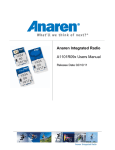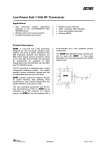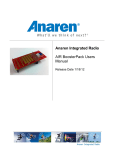Download Anaren A2500R24x User`s manual
Transcript
Anaren Integrated Radio A2500R24x User’s Manual Release Date: 09/05/12 THIS PAGE INTENTIONALLY LEFT BLANK USER’S MANUAL Models A2500R24A and A2500R24C Contents 1. Overview .......................................................................................................................................................... 5 1.1. A2500R24A .................................................................................................................................................5 1.2. A2500R24C .................................................................................................................................................5 1.3. Features....................................................................................................................................................... 6 1.4. Theory of Operation..................................................................................................................................6 1.4.1. Typical Flow ........................................................................................................................................9 1.5. Applications ............................................................................................................................................. 11 1.6. Configuration ........................................................................................................................................... 11 2. Approvals and Usage ................................................................................................................................... 13 2.1. Product Approvals .................................................................................................................................. 13 2.1.1. USA (Federal Communications Commission, FCC) ......................................................................... 13 2.1.1.1. FCC Labeling Requirements ................................................................................................ 13 2.1.1.2. End User Manual ................................................................................................................... 14 2.1.1.3. RF Exposure ............................................................................................................................ 14 2.1.2. Canada (Industry Canada, IC) .......................................................................................................... 15 2.1.2.1. IC Labeling Requirements .................................................................................................... 16 2.1.2.2. RF Exposure ............................................................................................................................ 17 2.1.3. Europe (Conformité Européenne, ) ............................................................................................... 18 2.2. Potential Interference Sources ............................................................................................................... 18 2.2.1. WLAN ............................................................................................................................................... 19 2.2.2. Bluetooth® ......................................................................................................................................... 19 2.2.3. Microwave ovens ............................................................................................................................... 19 2.2.4. Other Interference ............................................................................................................................. 19 2.2.5. Time critical data ............................................................................................................................... 20 2.3. Approved Usage ..................................................................................................................................... 20 2.3.1. USA and Canada............................................................................................................................... 21 2.3.2. Europe ............................................................................................................................................... 21 3. Electrical Characteristics .............................................................................................................................. 22 3.1. Absolute Maximum Ratings .................................................................................................................. 22 3.2. Operating Conditions ............................................................................................................................. 23 3.3. Pin Out ...................................................................................................................................................... 23 3.4. Recommended Layout (dimensions in mm) ...................................................................................... 25 3.5. Power Supply Considerations ............................................................................................................... 26 4. Mechanical and Process ................................................................................................................................ 27 4.1. Radio Module Details (dimensions in mm) ........................................................................................ 27 4.1.1. A2500R24A ...................................................................................................................................... 27 4.1.2. A2500R24C ....................................................................................................................................... 27 4.2. Packaging Details (dimensions in mm) ............................................................................................... 28 4.2.1. Matrix Tray Packaging ..................................................................................................................... 28 4.2.2. Tape-Reel Packaging ......................................................................................................................... 29 4.3. Soldering................................................................................................................................................... 30 4.3.1. Manual Mounting Procedure ........................................................................................................... 30 4.3.2. Automated Mounting Procedure ...................................................................................................... 31 THIS PAGE INTENTIONALLY LEFT BLANK A2500R24x – User’s Manual Release Date 09/05/12 Page 5 of 35 1. Overview The A2500R24C and A2500R24A are surface mount modules with an integrated crystal, internal voltage regulator, matching circuitry and filtering. The A2500R24A has an integral antenna, whereas the A2500R24C utilizes an external antenna through a U.FL connector (see Table 1). The modules operate in the global non-licensed 2.4GHz ISM/SRD frequency band and are ideal for achieving low power wireless connectivity without having to deal with extensive RF, antenna design and regulatory compliance, and provide quick time to market. The modules are 100% tested to provide consistent performance. The A2500R24C and A2500R24A have received regulatory approvals for modular devices in the United States (FCC), Canada (IC) and Europe (ETSI). The modular approval allows the OEM or end user to place either an A2500R24A or an A2500R24C with an approved antenna inside a finished product without having to perform costly regulatory testing for an intentional radiator. Section 2.3 has information on the requirements the end user/integrator must fulfill to use the modules without intentional radiator regulatory testing. The A2500R24C and A2500R24A are based on the CC2500 transceiver IC from Texas Instruments. All control lines for the transceiver are provided at module level for full control of its operation. Please see the CC2500 data sheet (www.ti.com) for how to control the modules. The A2500R24C and A2500R24A modules both measure 9x12x2.5mm and are footprint compatible with each other. 1.1. A2500R24A The A2500R24A has an integral antenna, providing high efficiency and near omni-directional radiation pattern. This approach offers the lowest system cost when the application allows collocation of radio and antenna. 1.2. A2500R24C The A2500R24C has a compact antenna connector that allows for locating the antenna away from the module due to form/function or in order to exit a metal enclosure, see Figure 8 – Figure 9 for more information on antenna location and enclosure considerations. Page 6 of 35 1.3. A2500R24x – User’s Manual Release Date 09/05/12 Features Features: Benefits Summary: Frequency range: 2400 – 2483.5 MHz Ultra small package size 9mm x 12mm x 2.5mm Impedance controlled multi-layer PCB Shielded Package 1.8 to 3.6 V operation SPI Interface RoHS Compliant Approximate weight 0.4 grams LGA Footprint Low Power Consumption Digital RSSI output Programmable channel filter bandwidth Programmable output power up to +1 dBm High sensitivity (–104 dBm at 2.4 kBaud, 1% packet error rate) Low current consumption (13.3 mA in RX, 250 kBaud, input well above sensitivity limit) Separate 64-byte RX and TX data FIFOs Fast startup time: 250µs from SLEEP to Rx or Tx mode Data Rate: 1.2 – 500 Kbit/Sec Programmable data rate from 1.2 to 500 kBaud Sleep state: 0.4µA Idle State: 1.5mA 1.4. Operating temperature -40 to +85C 100% RF Tested in production Common footprint for all family members No RF engineering experience necessary Only requires a 2 layer PCB implementation Excellent receiver selectivity and blocking Performance Suitable for frequency hopping and multichannel systems due to a fast settling frequency synthesizer with 90 µs settling time FCC 15.247, IC RSS-210 and IC RSSGen certified. Compliant with ETSI EN 300 328 No regulatory “Intentional radiator” testing required for integrating module into end product. Simple certification labeling replaces testing. Theory of Operation The A2500R24C and A2500R24A are for low power wireless applications in the 2400MHz to 2483.5MHz global ISM/SRD band. The devices can be used to implement a variety of networks, including; point to point, point to multipoint, peer to peer and mesh networks. The A2500R24C and A2500R24A both interface to an application microcontroller via an SPI bus. Physical and MAC layer functionality are accessed via the SPI bus, through addressable registers as well as execution commands. Data received or to be transmitted are also accessed through the SPI bus and are implemented as a FIFO register (64 bytes each for Tx and Rx). To transmit, a frame of data is placed in the FIFO; this may include a destination address. A transmit command is given, which will transmit the data according to the initial setup of the A2500R24x – User’s Manual Release Date 09/05/12 Page 7 of 35 registers. To receive data, a receive command is given, which enables the unit to “listen” for a transmission and when one occurs put the received frame in the FIFO. When neither transmit nor receive is required, the device can enter either an Idle mode, from which it can quickly reenter receive/transmit mode, or a low power sleep mode, from which a crystal startup is also required prior to a receive/transmit operation. Below a block diagram is given for each of the A2500R24C and A2500R24A modules. Antenna o The antenna couples energy between the air and the AIR module. For applications where installations are done by an end user (non-professional), an omni-directional antenna pattern is desired such that the application will work equally well in any direction. Similarly for peer to peer or point to multipoint applications an omni-directional pattern is desired such that all nodes have a fair chance of communicating. The A2500R24A module has an integral antenna that is near omni-directional, whereas the A2500R24C has approved antenna options ranging from near omni-directional to shaped front/back patterns (useful for inline, professional installations). Note that the end radiation pattern depends not only on the antenna, but also on the ground plane, enclosure and installation environment. Filtering o Filtering removes spurious signals to comply with regulatory intentional radiator requirements. Matching o Matching provides the correct loading of the transmit amplifier to achieve the highest output power as well as the correct loading for the receive LNA to achieve the best sensitivity. Physical o The physical layer provides conversions between data, symbol and RF signal. MAC o The MAC layer is part of the Logical Link Layer and provides frame handling, addressing and medium access services. Microcontroller Interface o The microcontroller interface exposes registers and commands for the physical and MAC layers to a microcontroller. Power Management o Power management ensures a stable supply for the internal functions as well as providing means for a low power sleep mode (in which case, most of the transceiver is power off). Page 8 of 35 A2500R24x – User’s Manual Release Date 09/05/12 Figure 1 The functionality of the A2500R24A, using an integral antenna Figure 2 The functionality of the A2500R24C, using an external antenna. Table 1 Approved Antennas Item 1 2 3 4 Part Number Integral part of A2500R24A 66089-2406 66089-2430 66129-2480 Manufacturer Anaren Anaren Anaren Anaren Type Integral Antenna Monopole whip, 6mm lead Monopole whip, 30mm lead Patch. 80mm lead Gain 2 3 3 5 A2500R24x – User’s Manual Release Date 09/05/12 Page 9 of 35 Figure 3 Transceiver IC block diagram. 1.4.1. Typical Flow Figure 4 shows the normal operation flow diagram after initial setup of the registers for desired operation. In applications of infrequent data transmissions the transceiver would be in “sleep” mode to save power. From there, it would awaken and then enter “idle” mode. As part of the wake up process, the crystal oscillator is started (~250μs) and the digital microcontroller interface is powered up. Before transmit or receive, the frequency synthesizer needs to be started (“FS_Wakeup”) and, having been powered off (or idle for a while), the control loop of the VCO/PLL needs to be calibrated (“calibrate”). A data frame is loaded into the transmit FIFO and the “TX” mode is entered. The transceiver will transmit the data and enter “idle” mode after completion. When transmit is complete “RX” mode is entered to wait for the acknowledge frame. Once a frame is received the transceiver will again enter “idle” mode. If no acknowledge frame is received within a given timeout the data frame would be re-transmitted. If the acknowledge frame indicates that the data was received, the next data frame will be transmitted. After the last data frame has been transmitted successfully, the transceiver will again be put in “sleep” mode. Page 10 of 35 A2500R24x – User’s Manual Release Date 09/05/12 Medium access Figure 4 Transceiver state diagram A2500R24x – User’s Manual Release Date 09/05/12 1.5. Page 11 of 35 Applications Ultra low-power wireless applications operating in the 2400-2483.5 MHz ISM/SRD bands. Typical applications are: Wireless alarm and security systems Industrial monitoring and control Wireless sensor networks AMR – Automatic Meter Reading Home and building automation Wireless game controllers Wireless audio Wireless keyboard and mouse RF enabled remote controls Existing applications where simple upgrade to wireless is desired 1.6. Configuration Table 2 lists the radio module configuration parameters, and the level of configurability by the user. Legend: Certification is valid for any value choosen Use the provided certified settings as other may degrade performance Any modification of this value is a violation of the certification and the customer is responsible for optaining their own certification Unused/undocumented function. The provided default value must be written. No assumption should be made on the value read from this field Read only register (burst mode read only, command strobes otherwise). Page 12 of 35 A2500R24x – User’s Manual Release Date 09/05/12 Table 2 Configuration Parameters Register Name IOCFG2 IOCFG1 IOCFG0 FIFOTHR SYNC1 SYNC0 PKTLEN PKTCTRL1 PKTCTRL0 ADDR CHANNR FSCTRL1 FSCTRL0 FREQ2 FREQ1 FREQ0 MDMCFG4 MDMCFG3 MDMCFG2 MDMCFG1 MDMCFG0 DEVIATN MCSM2 MCSM1 MCSM0 FOCCFG BSCFG AGCCTRL2 AGCCTRL1 AGCCTRL0 WOREVT1 WOREVT0 WORCTRL FREND1 FREND0 FSCAL3 FSCAL2 FSCAL1 FSCAL0 RCCTRL1 RCCTRL0 FSTEST PTEST AGCTEST TEST2 TEST1 TEST0 PARTNUM VERSION FREQOFF_EST LQI RSSI MARC_STATE WORTIME1 WORTIME0 PKTSTATUS VCO_VC_DAC TXBYTES RXBYTES RCCTRL1_STATUS RCCTRL0_STATUS PATABLE FIFO Bit Fields Within Register Register Retained Address during (Hex) sleep 7 6 5 4 3 2 1 0 00 1 0 GDO2_INV GDO2_CFG 01 1 GDO_DS GDO1_INV GDO1_CFG 02 1 GDO0_TEMP_SENSOR_ENABLE GDO0_INV GDO0_CFG 03 1 Reserved ADC_RETENTION CLOSE_IN_RX FIFO_THR 04 1 SYNC_MSB 05 1 SYNC_LSB 06 1 PACKET_LENGTH 07 1 PQT 0 CRC_AUTOFLUSH APPEND_STATUS ADR_CHK 08 1 0 WHITE_DATA PKT_FORMAT 0 CRC_EN LENGTH_CONFIG 09 1 DEVICE_ADDR 0A 1 CHAN 0B 1 0 0 FREQ_IF 0C 1 FREQOFF 0D 1 FREQ[23:22]=0 FREQ[21:16] 0E 1 FREQ[15:8] 0F 1 FREQ[7:0] 10 1 CHANBW_E CHANBW_M DRATE_E 11 1 DRATE_M 12 1 DEM_DCFILT_OFF MOD_FORMAT MANCHESTER_EN SYNC_MODE 13 1 FEC_EN NUM_PREAMBLE 0 CHANSPC_E 14 1 CHANSPC_M 15 1 0 DEVIATION_E 0 DEVIATION_M 16 1 0 RX_TIME_RSSI RX_TIME_QUAL RX_TIME 17 1 0 CCA_MODE RXOFF_MODE TXOFF_MODE 18 1 0 FS_AUTOCAL PO_TIMEOUT PIN_CTRL_EN XOSC_FORCE_ON 19 1 0 FOC_BS_CS_GATE FOC_PRE_K FOC_POST_K FOC_LIMIT 1A 1 BS_PRE_K BS_PRE_KP BS_POST_K BS_POST_KP BS_LIMIT 1B 1 MAX_DVGA_GAIN MAX_LNA_GAIN MAGN_TARGET 1C 1 0 AGC_LNA_PRIORITY CARRIER_SENSE_REL_THR CARRIER_SENSE_ABS_THR 1D 1 HYST_LEVEL WAIT_TIME AGC_FREEZE FILTER_LENGTH 1E 1 EVENT0[15:8] 1F 1 EVENT0[7:0] 20 1 RC_PD EVENT1 RC_CAL 0 WOR_RES 21 1 LNA_CURRENT LNA2MIX_CURRENT LODIV_BUF_CURRENT MIX_CURRENT 22 1 0 LODIV_BUF_CURRENT_TX 0 PA_POWER 23 1 FSCAL3[7:6] CHP_CURR_CAL_EN FSCAL3[3:0] 24 1 0 VCO_CORE_H_EN FSCAL2 25 1 0 FSCAL1 26 1 0 FSCAL0 27 1 0 RCCTRL1 28 1 0 RCCTRL0 29 0 FSTEST 2A 0 PTEST 2B 0 AGCTEST 2C 0 TEST2 2D 0 TEST1 2E 0 TEST0[7:2] VCO_SEL_CAL_EN TEST0[0] 2F 30 1 PARTNUM 31 1 VERSION 32 0 FREQOFF_EST 33 0 CRC_OK LQI_EST 34 0 RSSI 35 0 MARC_STATE 36 0 TIME[15:8] 37 0 TIME[7:0] 38 0 CRC_OK CS PQT_REACHED CCA SFD GDO2 GDO0 39 0 VCO_VC_DAC 3A 0 TXFIFO_UNDERFLOW NUM_TXBYTES 3B 0 RXFIFO_OVERFLOW NUM_RXBYTES 3C 0 RCCTRL1_STATUS 3D 0 RCCTRL0_STATUS 3E 1 PATABLE 3F 0 TXFIFO/RXFIFO A2500R24x – User’s Manual Release Date 09/05/12 Page 13 of 35 2. Approvals and Usage The A2500R24C and A2500R24A have been designed to meet most national regulations for world-wide ISM-band use. In particular, the radio modules have been certified to the following standards. 2.1. Product Approvals 2.1.1. USA (Federal Communications Commission, FCC) The A2500R24A, with integrated antenna, as well as the A2500R24C, used with the antennas listed in Table 1, have been tested to comply with FCC CFR47 Part 15 sub-part C “Intentional Radiators”. The devices meet the requirements for modular transmitter approval as detailed in FCC public notice DA 00-1407 Released: June 26, 2000. The modular transmitter approval eliminates the need to re-perform costly ‘intentional radiator’ testing when submitting an end product for certification. (15.19a3) The modules comply with part 15 of the FCC rules. Operation is subject to the following two conditions: (1) this device may not cause harmful interference, and (2) this device must accept any interference received, including interference that may cause undesired operation. Any changes or modifications not expressly approved by the party responsible for compliance could void the user’s authority to operate the equipment. 2.1.1.1. FCC Labeling Requirements The A2500R24A and A2500R24C modules have been labeled with their own FCC ID number and if the FCC ID is not visible when the module is installed inside another device, then the outside of the finished product into which the module is installed must also display a label referring to the enclosed module. This exterior label can use wording such as the following: Contains Transmitter Module FCC ID: X7J-A10030501 -orContains FCC ID: X7J-A10030501 This device complies with Part 15 of the FCC Rules. Operation is subject to the following two conditions: (1) this device may not cause harmful interference, and (2) this device must accept any interference received, including interference that may cause undesired operation. Page 14 of 35 2.1.1.2. A2500R24x – User’s Manual Release Date 09/05/12 End User Manual The end user manual should include the following statement: This equipment has been tested and found to comply with the limits for a Class B digital device, pursuant to part 15 of the FCC Rules. These limits are designed to provide reasonable protection against harmful interference in a residential installation. This equipment generates, uses and can radiate radio frequency energy and, if not installed and used in accordance with the instructions, may cause harmful interference to radio communications. However, there is no guarantee that interference will not occur in a particular installation. If this equipment does cause harmful interference to radio or television reception, which can be determined by turning the equipment off and on, the user is encouraged to try to correct the interference by one or more of the following measures: Reorient or relocate the receiving antenna. Increase the separation between the equipment and receiver. Connect the equipment into an outlet on a circuit different from that to which the receiver is connected. Consult the dealer or an experienced radio/TV technician for help. 2.1.1.3. RF Exposure All transmitters regulated by the FCC must comply with RF exposure requirements. OET Bulletin 65 “Evaluating Compliance with FCC Guidelines for Human Exposure to Radio Frequency Electromagnetic Fields” provides assistance in determining whether proposed or existing transmitting facilities, operations or devices comply with limits for human exposure to Radio Frequency (RF) fields adopted by the Federal Communications Commission (FCC). The bulletin offers guidelines and suggestions for evaluating compliance. If appropriate, compliance with exposure guidelines for mobile and unlicensed devices can be accomplished by the use of warning labels and by providing end users with information concerning minimum separation distances from transmitting structures and proper installation of antennas. The following statement must be included as a CAUTION statement in manuals and OEM products to alert end users of FCC RF Exposure compliance: To satisfy FCC RF Exposure requirements for mobile and base station transmission devices, a separation distance of 20 cm or more should be maintained between the antenna of this device and persons during operation. To ensure compliance, operation at closer than this distance is not recommended. The antenna(s) used for this transmitter must not be co-located or operating in conjunction with any other antenna or transmitter. If the A2500R24A and A2500R24C modules are used in a portable device (antenna is less than 20 cm from persons during operation), the end user is responsible for performing Specific Absorption Rate (SAR) testing in accordance with FCC rules 2.1093. A2500R24x – User’s Manual Release Date 09/05/12 Page 15 of 35 2.1.2. Canada (Industry Canada, IC) The A2500R24A and A2500R24C modules have been certified for use in Canada under Industry Canada (IC) Radio Standards Specifications (RSS) RSS-210 and RSS-Gen. From section 3.2 RSS-Gen, Issue 3, December 2010, Modular Approval for Category I Equipment or Category II Equipment: “Modular approval permits the installation of the same module in a host device or multiple host devices without the need to recertify the device. Equipment certification for a modular device may be sought for either Category I equipment or Category II equipment. Transmitters designed as modules for the installation in a host device may obtain equipment certification as a modular device provided that the applicable RSS is met and the following conditions in this section are met.” In RSS-Gen section 7.1.2 Transmitter Antenna, it has been mentioned that the user manuals for transmitters shall display the following notice in a conspicuous location: Notice: Under Industry Canada regulations, this radio transmitter may only operate using an antenna of a type and maximum (or lesser) gain approved for the transmitter by Industry Canada. To reduce potential radio interference to other users, the antenna type and its gain should be so chosen that the equivalent isotropically radiated power (e.i.r.p.) is not more than that necessary for successful communication. Avis: Sous la réglementation d'Industrie Canada, ce transmetteur radio ne peut fonctionner qu’en utilisant seulement une antenne d'un type et d’un maximum (ou moins) de gain approuvé pour l'émetteur par Industrie Canada. Pour réduire des potentielles interférences radio pour les autres utilisateurs, le type d'antenne et son gain doivent être choisis de sorte que la puissance isotrope rayonnée équivalente (PIRE) ne dépasse pas ce qui est nécessaire pour une communication réussie. In RSS-Gen section 7.1.2 Transmitter Antenna, it has been mentioned that the user manuals for transmitters equipped with detachable antennas shall also contain the following notice in a conspicuous location: Notice: This radio transmitter (IC: 8975A-A10030501) has been approved by Industry Canada to operate with the antenna types listed below with the maximum permissible gain and required antenna impedance for each antenna type indicated. Antenna types not included in this list, having a gain greater than the maximum gain indicated for that type, are strictly prohibited for use with this device. Avis: Cet émetteur radio (IC: 8975A-A10030501) a été approuvé par Industrie Canada pour fonctionner avec les types d'antennes énumérés ci-dessous avec le gain maximal admissible et l’impédance d'antenne requise pour chaque type d'antenne indiqué. Les types d'antennes ne figurant pas dans cette liste, ayant un gain supérieur au gain maximal indiqué pour ce type, sont strictement interdits pour l'utilisation avec cet appareil. Page 16 of 35 2.1.2.1. A2500R24x – User’s Manual Release Date 09/05/12 IC Labeling Requirements From section 3.2.1 RSS-Gen, Issue 3, December 2010, Labeling Requirements for the Host Device: The host device shall be properly labeled to identify the modules within the host device. The Industry Canada certification label of a module shall be clearly visible at all times when installed in the host device, otherwise the host device must be labeled to display the Industry Canada certification number of the module, preceded by the words “Contains transmitter module”, or the word “Contains”, or similar wording expressing the same meaning. From section 5.2, RSS-Gen, Issue 3, December 2010, Equipment Certification Numbers and Labels: Every unit of Category I radio apparatus certified for marketing and use in Canada shall bear a permanent label on which is indelibly displayed the model number and Industry Canada certification number of the equipment model (transmitter, receiver, or inseparable combination thereof). Each model shall be identified by a unique combination of a model number and a certification number, which are assigned as described below in this section. The label shall be securely affixed to a permanently attached part of the device, in a location where it is visible or easily accessible to the user, and shall not be readily detachable. The label shall be sufficiently durable to remain fully legible and intact on the device in all normal conditions of use throughout the device’s expected lifetime. These requirements may be met either by a separate label or nameplate permanently attached to the device or by permanently imprinting or impressing the label directly onto the device. The label text shall be legible without the aid of magnification, but is not required to be larger than 8-point font size. If the device is too small to meet this condition, the label information may be included in the user manual upon agreement with Industry Canada. Section 5.2 continues: The model number is assigned by the applicant and shall be unique to each model of radio apparatus under that applicant’s responsibility. The model number shall be displayed on the label preceded by the text: “Model:”, so it appears as follows: Model: model number assigned by applicant From section 7.1.4, RSS-Gen, Issue 3, December 2010, Radio Apparatus Containing Digital Circuits (ICES-003): “Radio apparatus containing digital circuitry which can function separately from the operation of a transmitter or an associated transmitter, shall comply with ICES-003. In such cases, the labeling requirements of the applicable RSS apply, rather than the labelling requirements in ICES-003.” A2500R24x – User’s Manual Release Date 09/05/12 Page 17 of 35 Label: Contains IC: 8975A-A10030501 Notice: This device complies with Industry Canada licence-exempt RSS standard(s). Operation is subject to the following two conditions: (1) this device may not cause interference, and (2) this device must accept any interference, including interference that may cause undesired operation of the device. Avis: Cet appareil est conforme avec Industrie Canada RSS standard exempts de licence (s). Son fonctionnement est soumis aux deux conditions suivantes: (1) cet appareil ne peut pas provoquer d'interférences et (2) cet appareil doit accepter toute interférence, y compris les interférences qui peuvent causer un mauvais fonctionnement du dispositif. For more information, see: Industry Canada http://www.ic.gc.ca/. 2.1.2.2. RF Exposure All transmitters regulated by IC must comply with RF exposure limits as set forth in RSS-102, Issue 4, section 4, “Exposure Limits”. Furthermore RSS-102, Issue 4, Section 2 “Certification Requirements”, provides assistance in determining the specific requirements for compliance. If appropriate, compliance with exposure guidelines for mobile and unlicensed devices can be accomplished by the use of warning labels and by providing users with information concerning minimum separation distances from transmitting structures and proper installation of antennas. The following statement must be included as a CAUTION statement in manuals and OEM products to alert users of IC RF Exposure compliance: Notice: To satisfy IC RF Exposure requirements for mobile and base station transmission devices, a separation distance of 20 cm or more should be maintained between the antenna of this device and persons during operation. To ensure compliance, operation at closer than this distance is not recommended. The antenna(s) used for this transmitter must not be co-located or operating in conjunction with any other antenna or transmitter. Avis: Pour répondre à la IC d'exposition pour les besoins de base et mobiles dispositifs de transmission de la station, sur une distance de séparation de 20 cm ou plus doit être maintenue entre l'antenne de cet appareil et les personnes en cours de fonctionnement. Pour assurer le respect, l'exploitation de plus près à cette distance n'est pas recommandée. L'antenne (s) utilisé pour cet émetteur ne doit pas être co-localisés ou fonctionner conjointement avec une autre antenne ou transmetteur. If the A2500R24A and A2500R24C modules are used in a portable application (antenna is less than 20 cm from persons during operation), the integrator/OEM is responsible for performing Specific Absorption Rate (SAR) testing in accordance with IC rules and methods of RSS-102. Page 18 of 35 A2500R24x – User’s Manual Release Date 09/05/12 2.1.3. Europe (Conformité Européenne, ) The A2500R24A and A2500R24C modules have been certified for use in European countries. The following tests have been performed and the module found to be compliant to the requirements: Test standard ETSI EN 300 328 V1.7.1 (2006-10) Maximum Isotropic Radiated Power (Normal and Extreme Conditions) Maximum e.i.r.p. Spectral Density Frequency Range (Normal and Extreme Conditions) Transmitter Spurious Emissions Receiver Spurious Emissions Electro-Static Discharge and RF Immunity (ETSI EN 301 489-17) RF Exposure (ETSI EN 62311:2008) Safety (IEC 60950-1:2005 and EN 60950-1:2006) A helpful document that can be used as a starting point in understanding the use of short range devices (SRD) in Europe is the European Radio Communications Committee (ERC) Recommendation 70-03 E, downloadable from the European Radio Communications Office (ERO) http://www.ero.dk. The end user is responsible for ensuring compliance with harmonized frequencies and labeling requirements for each country the end device is marketed and sold. For more information see: Radio And Telecommunications Terminal Equipment (R&TTE) http://ec.europa.eu/enterprise/rtte/index_en.htm European Conference of Postal and Telecommunications Administrations (CEPT) http://www.cept.org/ European Telecommunications Standards Institute (ETSI) http://www.etsi.org/ European Radio Communications Office (ERO) http://www.ero.dk/ 2.2. Potential Interference Sources The radio modules operate in the unlicensed ISM band, in which there are many other applications e.g. WLAN, Bluetooth® and microwave ovens. This can cause interference that may, in certain conditions, prohibit radio communication. The user is encouraged to implement a number of channels and to alternate between those channels based on one of the below methods. Sense if a particular channel is clear prior to transmitting (clear channel assessment) Pseudo Random channel change Select channels with the least interference (site survey) A2500R24x – User’s Manual Release Date 09/05/12 Page 19 of 35 Some of the most common interferences are listed below. 2.2.1. WLAN Wireless Local Area Networks (WLANs) are divided into a number of overlapping channels. Figure 5 below shows the channels used by WLAN; for the US and Canada, only channels 1-13 may be used. Predominantly, channels 1, 6 and 11 are used to achieve non-overlapping channels. The user is therefore encouraged to select a channel scheme that also has channels falling in between, or entirely outside, WLAN channels. Using a detection scheme (clear channel assessment) will enable the user to find channels with minimal interference from WLAN devices. Figure 5 WLAN channels 2.2.2. Bluetooth® Bluetooth® divides the 2.402-2.480 GHz band into 79 channels, each of which is 1MHz wide. However, since Bluetooth® changes channels rapidly (up to 1600 times a second), it is unlikely to cause continuous interference in a specific channel and can be overcome by implementing a simple acknowledge/retransmit functionality. 2.2.3. Microwave ovens A typical microwave oven uses a self-oscillating magnetron with a duty cycle below 50%, because the tube is completely off for half of every AC mains cycle (8.33 ms in 60 Hz countries and 10 ms in 50 Hz countries). The frequency of the microwave oven changes cyclically within each AC mains synchronized on period, and is generally not predictable. The user is encouraged to have packet transmission durations less than half the AC mains period and implement an acknowledge/retransmit method. 2.2.4. Other Interference Systems similar to the user’s system may also exist within range and may also be a source of interference; some typical applications to consider are: Alarm systems o These typically use low duty cycles and are therefore easy to avoid using acknowledge/retransmit methods Car alarms (internal motion sensors) Video surveillance Page 20 of 35 o A2500R24x – User’s Manual Release Date 09/05/12 These are typically operated on a fixed channel, determined at installation time and can be avoided by using clear channel assessment. It may be useful to change the channel used by the video surveillance equipment also, if possible. 2.2.5. Time critical data If the user requires specific time critical data throughput that cannot tolerate the delays of potentially many re-transmissions, the user is encouraged to implement an environment-aware algorithm that periodically monitors/scans the frequency band and maintain a list of “best available” channels. 2.3. Approved Usage The A2500R24A and A2500R24C modules have been approved for use in the US, Canada and Europe. The user is encouraged to use minimum power required to establish a link, thus minimizing interference. Changes or modifications to the module and/or operation outside the limits are prohibited and could void the user’s authority to operate the modules. Table 3 shows the certified modulation types and data rates along with recommended channel spacing values. These configurations are common for FCC, IC and Europe. Table 3 Certified configurations for FCC, IC and ETSI Modulation Type Datarate (kbps) Deviation (kHz) Phase Transition Channel Spacing (kHz) RX Filter BW (kHz) 1.2 140 NA 310.242 650 2.4 140 NA 310.242 650 4.8 140 NA 310.242 650 10 140 NA 310.242 650 2-FSK 20 140 NA 310.242 650 38 140 NA 310.242 650 100 140 NA 310.242 650 250 140 NA 310.242 650 MSK 500 NA 0 307.861 812.5 Table 4 shows certified frequencies of operations for each modulation type. Center frequencies outside the specified band,[Fcmin, Fcmax], are prohibited, and therefore should not be used for communication. Table 4 Certified frequencies of operations and power levels for FCC, IC and ETSI Modulation Type Fcmin(MHz) Fcmax (MHz) Max. Output Power (dBm) PA_Table (Hex) 2-FSK MSK 2401.3 2401.8 2480.4 2480.3 1 1 0xFF 0xFF A2500R24x – User’s Manual Release Date 09/05/12 Page 21 of 35 Table 5 shows available power levels from the device along with the corresponding PA_Table register settings. Users are encouraged to use minimum power required to establish a link, thus minimizing interference and current consumption. Table 5 Output Power vs. PA Table Value Power (dBm) PA_Table (Hex) Power (dBm) PA_Table (Hex) 1 0xFF -16 0x55 0 0xFE -18 0x93 -2 0xBB -20 0x46 -4 0xA9 -22 0x81 -6 0x7F -24 0x84 -8 0x6E -26 0xC0 -10 0x97 -28 0x44 -12 0xC6 -30 0x50 -14 0x8D -55 0x00 2.3.1. USA and Canada Within the USA and Canada, the A2500R24A and A2500R24C modules have been approved for use as digitally modulated transmitters, for which they conform to the BW (a minimum of 500 kHz 6-dB BW for US, a maximum BW of 0.5% of the carrier frequency for Canada), power spectral density (max of 8 dBm / 3 kHz), total output power (max 1W including the antenna gain) and spurious radiation (harmonics and others including the restricted bands) requirements. In a frequency-agile implementation or an implementation with multiple systems sharing the same location, the user is encouraged to use only even channel numbers for 2-FSK, and every 3rd or 4th channels for MSK modulations to avoid overlapping channels (127 channels for 2-FSK, and 85 or 64 channels for MSK would thus be available). It is encouraged to use a medium access technique which should include individual transceiver nodes addressing; and should include a combination of a clear channel assessment, transmit and detect, or a frequency hopping method. This ensures that the un-licensed band can be shared with other systems/applications. 2.3.2. Europe For Europe, the maximum allowed power is 100mW (20 dBm) with a maximum spectral power density of 10mW/MHz (10 dBm/MHz); but there is no minimum occupied bandwidth requirement. For Europe a medium access protocol is required. The transceiver module provides the following medium access services: Clear channel assessment 8 bit address Receive packet qualification (Address, CRC) Packetized/Frame handling. Page 22 of 35 A2500R24x – User’s Manual Release Date 09/05/12 3. Electrical Characteristics 3.1. Absolute Maximum Ratings Under no circumstances shall the absolute maximum ratings given in Table 6 be violated. Stress exceeding one or more of the limiting values may cause permanent damage to the device. Caution! ESD sensitive device. Precaution should be used when handling the device in order to prevent permanent damage. Caution! This assembly contains moisture sensitive devices and requires proper handling per IPC/JEDEC J-STD-033 Table 6 Absolute Maximum Ratings Parameter Min Max Unit Supply Voltage (Vdd) -0.3 3.9 V Voltage on any digital pin -0.3 Vdd+0.3, max 3.9 V +10 dBm 150 ˚C Solder reflow temperature 260 ˚C According to IPC/JEDEC JSTD-020D ESD <500 V According to JEDEC STD 22, method A114, Human body model ESD 400 V According to JEDEC STD 22, C101C, Charged Device Model (CDM) RF input power Storage Temperature -50 Condition/Note A2500R24x – User’s Manual Release Date 09/05/12 3.2. Page 23 of 35 Operating Conditions Table 7 Operating Conditions Parameter Min Max Unit Supply Voltage (Vdd) 1.8 3.6 V Temperature Range -40 +85 ˚C 3.3. Condition/Note Pin Out The A2500R24C and A2500R24A radio modules share a common pin-out and foot print, that is also shared by Anaren modules using other frequencies -- thus enabling easy changeover from one to another, e.g. if changing the frequency, antenna scheme, or adaptive antenna tuning is desired. Below the common footprint are shown. NC = “NO Connection”. connected internally. Pin is NOT DNC = “Do Not Connect”. Pin reserved for internal use, ensure mating footprint pads are isolated. GND = “Ground”. Connect the maximum number possible (minimum one for proper operation). Figure 6 Pin Out. Page 24 of 35 A2500R24x – User’s Manual Release Date 09/05/12 Table 8 Pin Descriptions Pin # 1 Pin Name DNC Pin Type NC 2 DNC NC 3 DNC NC 4 NC NC 5 NC NC 6 NC NC 7 Vdcoup1 Analog 8 9 10 GND SCLK MISO/GDO1 11 12 13 MOSI _CSN GDO0 14 15 GDO2 Vdcoup2 Ground Digital Input Digital Output Digital Input Digital Input Digital I/O (Analog output) Digital I/O Analog 16 NC NC 17 18 GND Vdd 19 NC Ground Power Supply NC 20 NC NC 21 NC NC 22 DNC NC 23 DNC NC 24 DNC NC Description Internal GND connection used during testing, not recommended to connect to main GND. Internal RF output connection used during test. Connecting this pin to anything will require recertification for intentional radiators. Internal GND connection used during testing, not recommended to connect to main GND. Pin is not connected internally, but is reserved for future expansion. It is recommended not to connect this pin to anything. Pin is not connected internally, but is reserved for future expansion. It is recommended not to connect this pin to anything. Pin is not connected internally, but is reserved for future expansion. It is recommended not to connect this pin to anything. Optional decoupling of the modules internal Vdd supply. It is recommended to not connect anything to this pin. In particular noisy environment this pin can be used to further reduce the noise on the modules internal Vdd, please see section 3.5 for further information. One of two primary ground pins SPI bus clock signal SPI bus data out from radio when CSN is low, and general purpose I/O pin when CSN is high SPI bus data into radio SPI bus select (active low) General purpose port General purpose port Optional decoupling of the modules internal Vdd supply. It is recommended to not connect anything to this pin. In particular noisy environment this pin can be used to further reduce the noise on the modules internal Vdd, please see section 3.5 for further information. No Connect, the pin is not connected internally, but is reserved for future expansion. It is recommended not to connect this pin to anything. One of two primary ground pins Power supply pin Pin is not connected internally, but is reserved for future expansion. It is recommended not to connect this pin to anything. Pin is not connected internally, but is reserved for future expansion. It is recommended not to connect this pin to anything. Pin is not connected internally, but is reserved for future expansion. It is recommended not to connect this pin to anything. Internal GND connection used during testing, not recommended to connect to main GND. Pin is not connected internally, but is reserved for future expansion. It is recommended not to connect this pin to anything. Internal GND connection used during testing, not recommended to connect to main GND. A2500R24x – User’s Manual Release Date 09/05/12 3.4. Recommended Layout Page 25 of 35 (dimensions in mm) Figure 7 Recommended PCB layout. Page 26 of 35 A2500R24x – User’s Manual Release Date 09/05/12 Figure 8 Mounting the module in a corner 3.5. Figure 9 Mounting the module along an edge Power Supply Considerations Noise on the power supply line reduces the sensitivity of a receiver and modulates onto a transmitters signal, both of which causes a degradation of link quality and hence a reduction in range. The A2500R24C and A2500R24A radio modules each have an integral ferrite bead in the supply line from pin 18 (Vdd) and decoupling capacitance to reduce any noise on the incoming power supply line. This arrangement will eliminate most supply voltage noise. In particular noisy environments (switching regulators, motor controls, etc.), it may be necessary to add additional noise reduction means. Pin 7 (Vdcoup1) is connected to the modules internal supply line after the ferrite bead and decoupling capacitors and can be used to probe the noise at module level. The noise level measured on pin 7 should not exceed 120mVpp when in transmit or receive mode, it may however exceed this value when setting up or accessing data to/from the FIFO’s while not actively transmitting or receiving. If the level measured is exceeding the above limit, steps should be taken to ensure maximum range, including: Adding decoupling capacitance to pin 7 (Vdcoup1). Adding additional filtering in the supply line. Adding an LDO in the supply line (the TPS731xx low Dropout Regulator from TI is recommended). A2500R24x – User’s Manual Release Date 09/05/12 Page 27 of 35 4. Mechanical and Process 4.1. Radio Module Details (dimensions in mm) 4.1.1. A2500R24A Figure 10 A2500R24A dimensions 4.1.2. A2500R24C Figure 11 A2500R24C dimensions Page 28 of 35 4.2. A2500R24x – User’s Manual Release Date 09/05/12 Packaging Details (dimensions in mm) AIR modules are available in Matrix Tray and Tape & Reel packaging for high-volume assembly. Details of packaging provided below: 4.2.1. Matrix Tray Packaging Figure 12 A2500R24AGM Matrix Tray Packaging Detail (30/Tray) Figure 13 A2500R24C00GM Matrix Tray Packaging Detail (40/Tray) A2500R24x – User’s Manual Release Date 09/05/12 4.2.2. Tape-Reel Packaging A2500R24A00GR Tape-Reel Packaging Detail (500/Reel) Figure 14 A2500R24A00GR Tape-Reel Packaging Detail (500/Reel) A2500R24C00GR Tape-Reel Packaging Detail (500/Reel) Figure 15 A2500R24C00GR Tape-Reel Packaging Detail (500/Reel) Page 29 of 35 Page 30 of 35 4.3. A2500R24x – User’s Manual Release Date 09/05/12 Soldering AIR Modules may be mounted either manually (for prototyping or low volume production), or automatically for high-volume production. A no-clean tin/silver/copper (SAC) solder is recommended, however lead based no-clean pastes may also be used. CAUTION: AIR Modules are designed for no-clean fluxes only. DO NOT use waterbased fluxes that require aqueous cleaning after solder. Spot cleaning with a flux remover and toothbrush may be performed with care. 4.3.1. Manual Mounting Procedure The recommended soldering method is reflow of a paste solder on a hot plate. This method works provided the bottom of the board where the AIR module is to be mounted is accessible, and there are no bottom-side components in the way. An aluminum or copper block may be placed on the hot plate surface to transfer heat to a localized area on the board where the AIR module is mounted - Set the hot plate to the reflow temperature solder manufacturer’s recommended Apply solder paste to the pads on the board receiving the AIR module Place the AIR module carefully onto the dispensed solder Using tweezers or another holding device, carefully place board with AIR module onto the hot plate surface (or metal block) Apply heat until reflow occurs, per solder paste manufacturer’s recommendations Carefully remove the board and place on a heat-resistant surface to cool Check assembly electrically to confirm there are no opens or shorts A2500R24x – User’s Manual Release Date 09/05/12 Page 31 of 35 4.3.2. Automated Mounting Procedure The AIR Radio Module recommended solder reflow profile is based on IPC/JEDEC J-STD-020. Page 32 of 35 A2500R24x – User’s Manual Release Date 09/05/12 A2500R24x – User’s Manual Release Date 09/05/12 Page 33 of 35 DOCUMENT HISTORY Date 05/31/10 07/15/10 12/17/10 01/10/11 07/06/11 Author Richardson Richardson Richardson Richardson Richardson 07/03/12 Sula 09/05/12 Richardson Change Note No./Notes Initial Draft Initial Release Formatting applied – no content change Corrected typographic errors Corrected typographic errors / added process section Modified Section 2.3 Approved Usage, and did misc. corrections. Updated format to latest standard, updated diagrams THIS PAGE INTENTIONALLY LEFT BLANK Attach distributor contact information here If you have additional questions, need samples, or would like a quote – please email the AIR team at [email protected] . For a full list of our franchised distributors, please visit our website: http://www.anaren.com/air/ Anaren Microwave, Inc. 6635 Kirkville Road East Syracuse, NY 13057 Tel: +1 315 432 8909 +1 800 411 6596 Fax: +1 315 432 8970 Anaren Microwave (Europe), Inc. 12 Somerset House, Suite 16 & 17 Hussar Court, Waterlooville Hampshire, England P07-7SG Tel: +44 2392 232392 Fax: +44 2392 251369 Anaren Communication Suzhou Co. Ltd. No. 5 Chun Hui Road Wei Ting, Suzhou Industrial Park Suzhou 215122, PR China Tel: +86 512 6287 6400 Fax: +86 512 6274 9283



































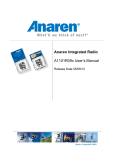
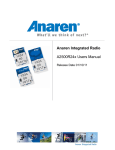
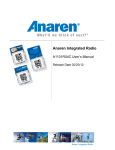
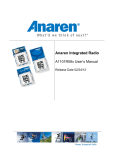
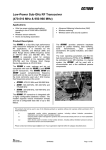
![Hacking Medical Devices - [media.blackhat.com]](http://vs1.manualzilla.com/store/data/005931227_1-f7547ce2b3ff0825b843d9b1dbb48800-150x150.png)
